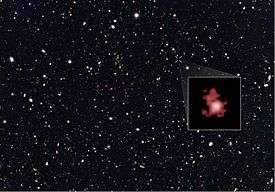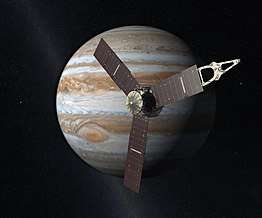Kepler-1638b
Kepler-1638 b is an exoplanet in orbit of its star, Kepler-1638, located in the constellation Cygnus. The planet is a super-Earth, with a radius of 1.87+0.33
−0.22 R⊕, and a mass of 4.16 Earths. It has an orbit of 259.337±0.013 days in its system's habitable zone and orbits 0.745 AU from its star. It is the farthest potentially habitable exoplanet discovered, at approximately 2,867.000 light-years (879.0262 pc) from Earth.[1][2][3]
| Discovery | |
|---|---|
| Discovered by | Ames Research Center |
| Discovery date | 2016 |
| Transit | |
| Orbital characteristics | |
| 259.337±0.013 d | |
| Star | Kepler-1638 |
| Physical characteristics | |
Mean radius | 1.87+0.33 −0.22 R⊕ |
References
- "Kepler-1638 b". NASA Exoplanet Science Institute. 10 May 2016. Retrieved 11 May 2016.
- Morton, Timothy D.; Bryson, Stephen T.; Coughlin, Jeffrey L.; Rowe, Jason F.; Ravichandran, Ganesh; et al. (May 2016). "False Positive Probabilities for all Kepler Objects of Interest: 1284 Newly Validated Planets and 428 Likely False Positives". The Astrophysical Journal. 822 (2). arXiv:1605.02825. Bibcode:2016ApJ...822...86M. doi:10.3847/0004-637X/822/2/86.
- Burgess, Matt (11 May 2016). "Nasa's Kepler telescope just found 1,284 exoplanets". Wired. Retrieved 21 June 2016.
This article is issued from Wikipedia. The text is licensed under Creative Commons - Attribution - Sharealike. Additional terms may apply for the media files.



